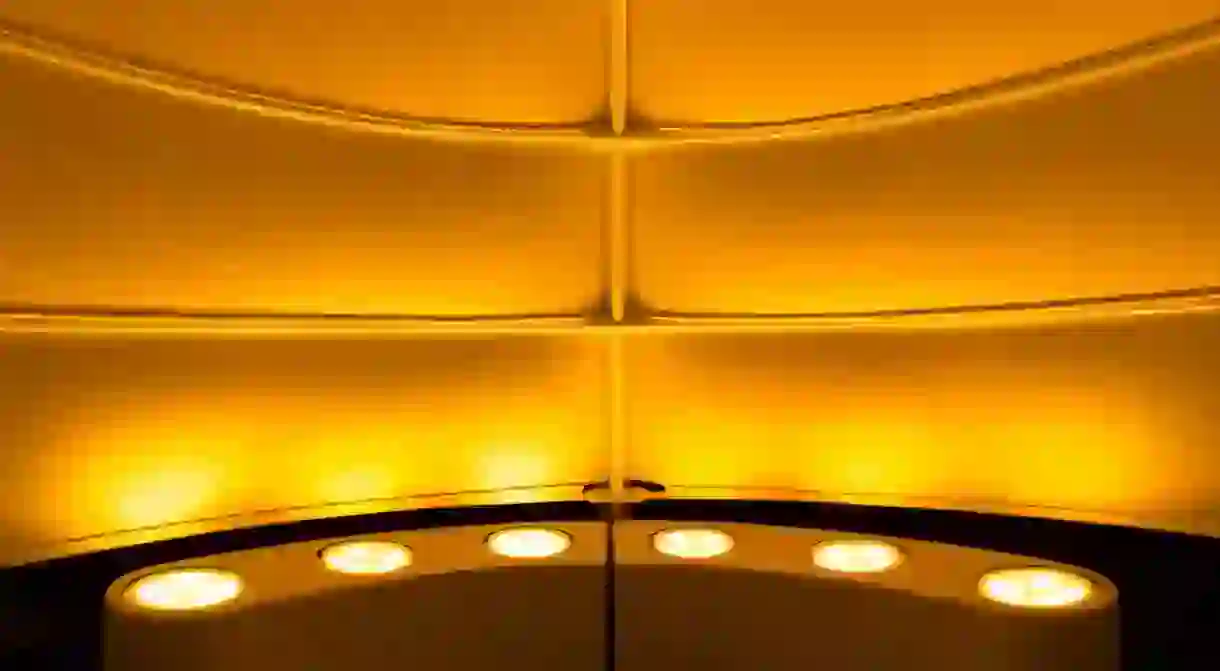Could Chromotherapy be the Ultimate Wellness Aid for Londoners?

To comprehend the impact of color, picture London on one of those overcast afternoons when the sun seems lethargic. The streets are muted and gloomy and so are the pedestrians, because feeling upbeat is difficult when your day is filtered through a shade of sludge-grey. Perhaps, then, it’s not entirely surprising that London’s wellness pioneers are exploring the power of colored light, and its therapeutic effect on our emotional and physiological health.
If you stepped into Shoreditch studio ChromaYoga outside of opening hours, it would look stark and unremarkable—a window-less, white cubic room without Hindu effigies or any of the usual yogic bric-a-brac. Its defining feature is only apparent when class is in session and monochromatic color illuminates the space.
This isn’t just about aesthetic (although it goes without saying that studios don’t come much more Instagrammable); the ChromaYoga concept is based on research into the effects of light therapy—the use of each shade’s distinct vibrational frequency to treat various conditions and ailments.

“Putting aside the initial emotional response that we all feel when stepping into a room saturated with one color, the reason ChromaYoga is so beneficial is because monochromatic light at specific frequencies can have a huge effect on your energy, mood, metabolism, circadian rhythms and muscles, which is complimentary to the styles of yoga we pair each color with,” explains founder Nina Ryner. “So, although it’s the first thing that people notice, the colors—or more specifically, light frequencies—focus much more on the physiological than the psychological. That’s why we don’t offer any blue classes after 3pm.”
You’ve probably heard about the perils of blue light emitted by your phone. It’s the one responsible for keeping you up after your nightly ritual of perusing Instagram, thanks to its suppressive affect on melatonin—the sleep hormone that governs the body’s circadian rhythms. This makes it a great color for ChromaYoga’s lunchtime class—a pick-me-up to increase afternoon productivity—but a no-no for the evening, when a restorative red, proven to improve sleep cycles, is much more beneficial. By braiding yoga with light therapy, Ryner has made the health benefits of the practice even more pronounced—an achievement that’s earned her studio a loyal following.
“A yellow class in the morning wakes me up, blue at lunch ignites my energy for a boost in the afternoon, and pink at the weekend settles me for a start to a new week,” says ChromaYoga student Fred Butler. As a bespoke accessories designer known for her bold and distinctive palettes, Butler has always been cognizant of the way color can influence emotions. “Color dictates and guides my life. I used to wear all one color and have a rainbow ordered wardrobe—I would wake up and feel a connection to a certain hue for that day,” she explains. “This has always been a subconscious action, so it was fascinating when I visited mycoocoon. I did their test [with a special app, designed to deduce] which color I needed that day, and when I took off my jacket I was wearing that exact shade of magenta.”

Magenta was also the shade I selected at mycoocoon—a pop-up chromotherapy pod created by Valérie Corcias and Dominique Kelly, co-founders of the the Pantone Universe licensing brand. This sensory immersion combines ancestral healing techniques (chromotherapy has roots stretching back to ancient Egypt and China) with modern technology, with the aim of restoring cellular and energetic balance.
Mycoocoon’s private showroom is on the 13th floor of a building on a quiet street in Soho. Set up just in front of a wide window, the cocoon’s rosy glow apposes a cityscape of grey concrete and grubby pigeons. Splayed out on the white leather lounger, bathed in magenta light, I placed a perfumed stick on my chest and a pair of headphones over my ears. Ambient sounds rose and fell over the bluetooth connection as I dozed off. It was cozy and safe-feeling under there—almost womb-like.
While the frequencies of other colors have scientifically corroborated physiological benefits, the perks of pink light are primarily emotional. It’s a shade associated with soft, sweet nurturing feelings, so we experience it as calming and comforting.
Regardless of whether it was placebo or not, that magenta light gave me a deep sense of peace and positivity I managed to hold on to for the remainder of the day—even at rush hour on the Northern Line! That’s something we could all use a little more of in this city of moody grey.













